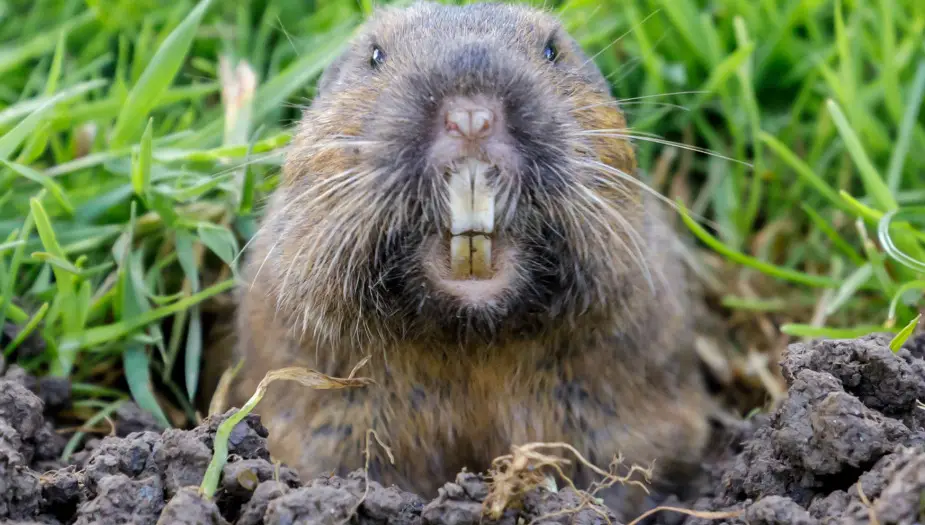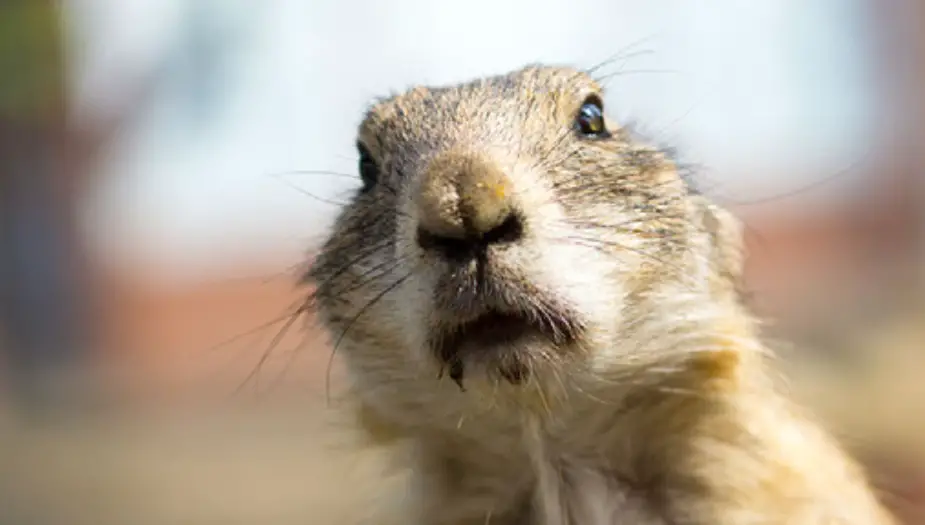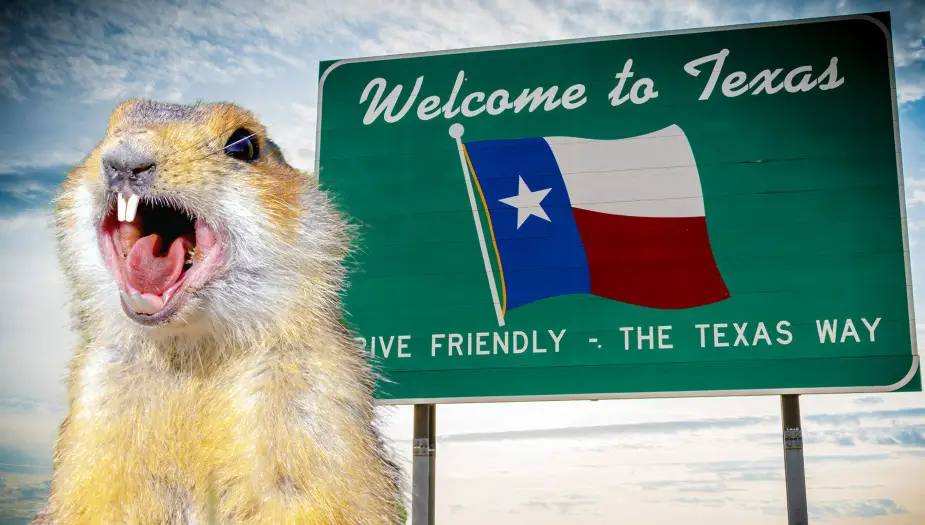Yes, there are gophers in Texas. Texas gophers are commonly found in these parts of Texas: south-central Texas near Austin, south and east of San Antonio, western Texas along the Rio Grande, and portions of the Gulf Coast.

Pocket Gophers in Texas
Pocket gopher populations in Texas vary from region to region. Generally, their numbers are greatest in areas with deep, silty, clayey soils and abundant vegetation.
Areas to the east of San Antonio have high concentrations of pocket gophers, while further eastward they become less common.
In western Texas, along the Rio Grande, pocket gopher populations can be sparse as the soils are often too hard or dry for them.
Texas Gopher Statistics
The most recent study of Texas gophers, conducted in 2020, estimated that there were around 5 million pocket gophers in the state.
Of these, about 1.2 million were located in the south-central region of Texas near Austin, while 2.1 million were found in areas east of San Antonio. Western Texas, along the Rio Grande, had an estimated 1.7 million pocket gophers.
What do Gophers eat in Texas: Diet & Habits
Pocket gophers in Texas mainly feed on plants, such as roots and tubers. They also eat insects, grubs and earthworms.
Gophers are active throughout the day and night, burrowing tunnels and searching for food. They create intricate tunnel systems beneath the soil in order to reach their food sources.
Gophers prefer to eat in the safety of their burrows and rarely venture out into open ground.
In addition to food, gophers in Texas also need a source of water. They drink from standing water and can travel up to 100 metres (328 feet) away from their burrow in search of a source.
Gophers are generally solitary creatures and defend their burrows aggressively against intruders, including other gophers. They communicate to potential threats by making loud chattering noises.
Texas Gopher Predators & Threats

In Texas, gophers are commonly preyed upon by foxes, coyotes, badgers, and snakes. They are also threatened by habitat destruction due to human development and agricultural activities.
In addition, gophers may be exposed to various pesticides, herbicides and other pollutants.
Texas gophers are doing well and their numbers remain stable in most areas of the state.
However, as their habitat continues to be threatened by human activities, it is important to take steps to protect these animals and ensure that their populations remain healthy.
How Can I Identify a Gopher in Texas ?
There are two primary species of gophers in Texas: the Rocky Mountain Pocket Gopher and the Plains Pocket Gopher.
The Rocky Mountain Pocket Gopher (Geomys bursarius) is found in the western half of Texas, while the Plains Pocket Gopher (Geomys personatus) is found in the eastern half of Texas.
They are smaller than their western counterparts, measuring between 5 and 7 inches long (12-18 cm) with grayish-brown fur on top and white fur on their underbellies.
Are Gophers Native to Texas?
Yes, gophers are native to the state of Texas. They have been present in the region for thousands of years and continue to be a vital part of the local ecosystem.
While they are not necessarily endangered, there are steps that can be taken to protect these animals and their habitats.
Texas Gopher Damage & Prevention
Gophers can cause extensive damage to crops and gardens by consuming roots and tubers and by digging deep tunnels.
The tunnels can also interfere with drainage systems, leading to flooding or erosion problems. To prevent gopher damage, it is important to remove food sources and to seal off potential entry points to your property.
Gopher Control in Texas – Top 3 Methods

Pocket gophers can be a major problem in both homes and farms, as they have the potential to cause significant damage.
In order to curb their population growth, Texans have developed several control techniques that are designed to reduce the number of gophers living in an area.
These strategies include trapping, poisoning, and mechanical means for controlling them. By taking advantage of these methods, it is possible to effectively manage pocket gopher populations before irreparable harm is done!
Texas Pocket Gopher Trapping
Trapping is the most common method used to control gopher populations in Texas. Strategically setting traps in places where gophers are known to appear is the most effective trapping method.
It is important to ensure that all traps are checked regularly, and any caught gophers must be disposed of humanely.
Texas Gopher Poisoning
Poisoning is another option for controlling pocket gopher populations in Texas. To successfully manage gopher populations, toxic baits are used as a solution.
To ensure safety, it is vital to only apply these chemicals in places where humans or other animals rarely traverse. Responsible utilization of such substances is imperative for the protection of those around us and ourselves.
Mechanical Gopher Control in Texas
Mechanical control is the last option for gopher control in Texas.
Combat gophers with this effective technique – use specialized instruments such as gopher plows and spades to dig up the soil, generating barriers which will ultimately block out these pesky critters.
Where Do Gophers Live in Texas?
Texas pocket gophers live in burrows in the ground. These animals prefer to live in areas where there is plenty of food and protection from predators.
They have been known to inhabit areas with loose, sandy soil, such as fields and pastures. They often live in groups and can create huge underground tunnel systems that span hundreds of square feet.
How Do Pocket Gophers Impact Texas’s Ecosystem?
Pocket gophers are important to Texas’s ecology. They help to aerate and mix soils, which in turn improves water infiltration.
They also provide food for predators like foxes, badgers, skunks, and coyotes. Additionally, their underground burrows provide refuges for other small animals such as snakes and lizards.
What do Texas Gophers look like?

Texas Gophers are small rodents that are closely related to moles and groundhogs. They have short legs and powerful claws on their front feet which they use for digging.
These animals are typically brown or black in color and have a small head, pointed snout, and rounded ears. Their tails are short and furry.
Their average size can range from 5 to 8 inches in length, with males typically being larger than the females.
Are Gophers Protected in Texas?
Gophers in Texas are not protected by the state. However, it is illegal to kill them without a permit from the Texas Parks and Wildlife Department.
Therefore, when dealing with gopher populations, it is important to use methods like trapping and poisoning which are proven effective but still in keeping with the law.
Mole Gophers in Texas
Mole gophers are found throughout the state of Texas. They prefer moist, sandy soils and are often found in areas with dense vegetation such as pastures and meadows.
Mole gophers are especially abundant in areas with high concentrations of earthworms and other soil invertebrates.
Are Pocket Gophers Dangerous in Texas?
Pocket gophers in Texas though generally not aggressive and rarely seen by humans, gophers can wreak havoc on crops and lawns as they dig for food.
Moreover, these animals may spread diseases like tularemia through their burrows or feces. To protect your property from destruction caused by these critters, it’s best to take precautionary steps ahead of time in order to keep them away!
Who should I call for Texas Gopher Control?
If you have a gopher problem in Texas, to avoid the destruction of your property, it is critical that you act quickly to control gopher populations.
For the most effective results and long-term prevention methods, hire a professional pest removal service with experience in handling pocket gophers. These services provide multiple strategies for controlling their numbers, like trapping and poisoning.
They can give useful advice on how to prevent future infestations from occurring again!
Texas Gopher Control FAQ:

What are Gophers?
Gophers, rodents of the mammalian species, are identified for their small, stocky build and grey coat. Not only that; they possess short limbs and ears as well!
Interestingly enough, Gophers have a pocket-like flap near their front teeth which is used to transport food – hence why they are known as ‘Pocket Gophers.’
Can Gophers Carry Diseases?
Indeed, gophers can transmit fatal illnesses to both humans and other animals. For instance, they frequently contain the bacteria accountable for tularemia – a deadly affliction.
Thus, it is of utmost importance that caution be applied when handling them; if you struggle with an infestation in your home or business grounds don’t hesitate to contact specialists right away!
Do Gophers Pose a Risk To Humans?
Gophers rarely pose a threat to humans and typically shy away from people. Nevertheless, it is crucial to be aware of them since their tunneling can create hazardous conditions in some cases.
What Can I Do to Help Prevent Gophers from Coming onto My Property?
To keep gophers from wreaking havoc on your property, it’s essential to make sure the area is free of debris and vegetation.
It’s important to trim trees and remove any leaves or branches that may have fallen onto the ground in order for them not to be attracted by a potential new home.
Regular mowing of your lawn as well as installing fencing or netting around its perimeter can also help repel these furry creatures away from your property.
Lastly, if you store pet food and birdseed indoors instead of outdoors this will decrease their chances of coming into search for food – making an unwanted visit much less likely!
How Can I Get Rid of Gophers in Texas?
Traps specifically designed for gophers are the most effective way of removal, although it is essential to remember that they must be checked and replaced regularly.
If traps don’t seem like a suitable option, chemical repellents can also be utilized with caution – but only as an absolute last resort.
Alternatively, flooding the tunnels with water may effectively ward off burrowing activity; however, this approach should only ever be used after all other methods have proved unsuccessful since unintended damage to landscaping or gardens could occur.

